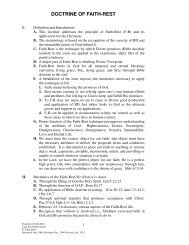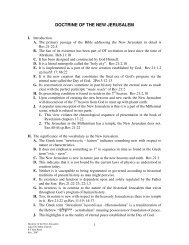Revelation 22 - Lake Erie Bible Church
Revelation 22 - Lake Erie Bible Church
Revelation 22 - Lake Erie Bible Church
Create successful ePaper yourself
Turn your PDF publications into a flip-book with our unique Google optimized e-Paper software.
Chapter <strong>22</strong><br />
<strong>Lake</strong> <strong>Erie</strong> <strong>Bible</strong> <strong>Church</strong><br />
P-T Ken Reed<br />
THE REVELATION TO JOHN<br />
36. Actually, both views are correct as it continues the thought of vs.1 and introduces the<br />
thought of vs.2.<br />
37. The prepositional phrase functions as a conjunction bridging the fact that both the<br />
river of life in vs.1 and the tree of life in vs.2 are both located in the middle of its<br />
street.<br />
38. The street in view is the same boulevard made of pure gold mentioned in 21:21.<br />
39. As noted in that verse, the street is symbolic as to the way of salvation by Divine<br />
design.<br />
40. Concerning eternal life, we note that the way of salvation would lead one to God,<br />
Jesus Christ and eternal life as well as salvation finding its ultimate source from all<br />
combined.<br />
41. While the river beautifully adorns the street’s median, we see additional elements<br />
complimenting both its beauty and symbolism, “And on either side of the river was<br />
the tree of life, bearing twelve kinds of fruit, yielding its fruit every month”.<br />
42. That the tree of life is directly associated with the river of life is apropos as both are<br />
symbolic of eternal life.<br />
43. The phrase “on either side ” is literally in the Greek, “from this place and from that<br />
place” and is correctly understood as being on both banks of the river.<br />
44. What has stumped many interpreters is that the tree of life is a singular, yet is seen<br />
growing in at least two places.<br />
45. Ecologically, the mystery is unraveled with understanding of the Aspen tree, native to<br />
North America and other parts of the world.<br />
46. This deciduous tree is of the Salicales family and Populus genus with many varieties.<br />
47. Most in the U.S. grow up 20–100 feet in height, but some of the giant poplars such as<br />
the black cottonwood are known to reach 200 feet with a diameter of 7-8 feet.<br />
48. One of the unique features of the Aspen is its root system that is extensive and often<br />
encompasses large areas.<br />
49. From the primary seedling/tree, lateral roots spread out producing sprouts with<br />
vertical sinker roots with depths of 5 feet or more.<br />
50. This produces a multitude of surface Aspen trees called a “stand”.<br />
51. This collection of multiple stems, called ramets, all form one single, genetic<br />
individual, usually termed a clone.<br />
52. Literally thousands of Aspens can be the result of one “stand”.<br />
53. The Pando tree a.k.a. the Trembling Giant is a clonal colony of a single male Quaking<br />
Aspen (Populus tremuloides) located in Utah, USA.<br />
54. With some debate, this particular Aspen is both the oldest and heaviest known living<br />
organism in existence weighing collectively some 6000 tonnes/metric tons (13.2<br />
million pounds).<br />
55. The size of the Pando encompasses 107 acres and has around 47,000 trunks<br />
56. After fires in areas of Aspen stands, the Aspen often resurfaces dominating the site<br />
producing a new, even-aged stand within a decade.<br />
57. Modern botanists now recognize the Aspen stand with its single root system as being<br />
literally one tree.<br />
58. Using the Aspen as a frame of reference, we can now visualize “one” tree of life that<br />
appears in a multiplicity of locations.<br />
4










